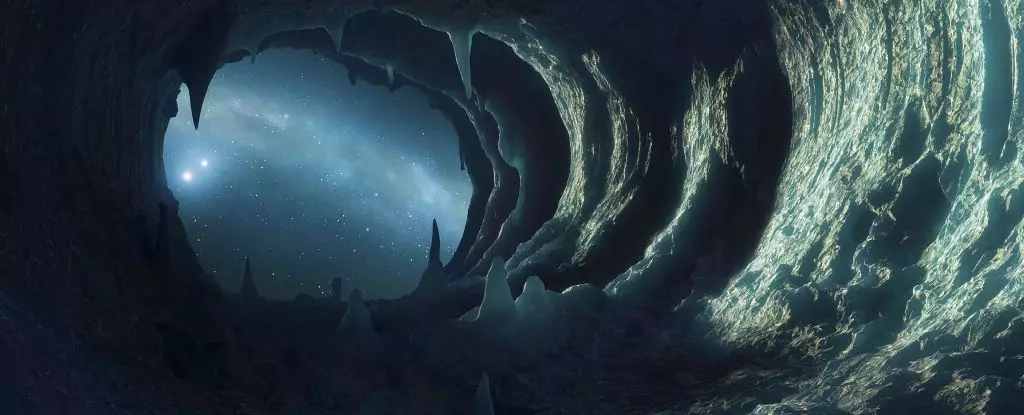Water, a seemingly simple molecule essential to life on Earth, emerges as an enigma when placed under the scrutiny of cosmic science. Traditionally, scientists presumed that water in the vast coldness of space existed predominantly as amorphous ice—disordered, featureless, and lacking any regular atomic structure—because the extreme temperatures and low energies purportedly prevented the formation of crystalline lattices. However, recent groundbreaking research challenges this straightforward assumption, revealing that space’s icy inhabitants are intricately patterned at a nanoscopic scale. This revelation does not just tweak our understanding; it fundamentally rewrites the narrative of how water behaves beyond our planet.
Advanced computer simulations combined with meticulous laboratory experiments suggest that the most prevalent form of cosmic ice might contain embedded crystalline regions, tiny but significant, which defy previous notions of amorphous uniformity. Instead of being a completely disorganized jumble, these ices are mosaics—largely amorphous but punctuated by nanometer-sized crystals. This nuanced structure hints at a level of order and complexity previously uncredited to ice floating through the cold expanse of space.
The implications of this are profound. If space ice isn’t entirely amorphous, then models describing planetary formation, comet behavior, and galaxy evolution may need reconsideration. Crystalline regions could influence how ice interacts with cosmic rays, how it regulates heat transfer, or how it facilitates chemical reactions crucial for molecular complexity in the universe. It’s a humbling reminder that even the simplest molecules, under the right conditions, can adopt unexpectedly complex forms.
Challenging Assumptions: The Cold Reality of Cosmic Ice
For centuries, scientists believed that enormous cosmic temperatures and rapid freezing events in space precluded the formation of ordered crystal structures. Instead, they categorized space ice as amorphous—disordered and lacking the repeating atomic patterns found in Earthly snow or ice cubes. This view aligned with observations of interstellar dust and cometary ices, which appeared featureless and non-crystalline in spectroscopic studies.
Yet, the new research suggests that such a binary perspective is overly simplistic. Through sophisticated simulations modeling water molecules cooling at different rates and experimental re-creations of space-like conditions, scientists have observed that even at ultra-low temperatures, tiny crystalline domains can emerge within an amorphous matrix. This is not an isolated or accidental occurrence; it appears to be a common, stable feature of space ice.
Crucially, the experiments show that when amorphous ice is warmed, it begins to develop these crystalline pockets—regardless of whether it formed directly from vapor deposition or was created by physically crushing ice at frigid temperatures. This indicates that the amorphous-crystalline boundary in space is more fluid than previously believed. There might be a delicate balance, with icy materials existing in a mosaic state that combines disorder and order in a way that impacts their physical and chemical behaviors.
The recognition that tiny crystalline regions may be embedded within cosmic ice challenges the assumption that space ice is purely amorphous. Instead, it could represent a form of metastable or partially ordered material, with properties that differ significantly from both fully crystalline and fully amorphous states. This paradigm shift invites scientists to reconsider how cosmic ices evolve over time and under varying environmental conditions.
Implications for Cosmology and Planetary Science
Understanding the true nature of cosmic ice has tangible consequences for multiple fields, from astrophysics to planetary geology. For example, the process of planet formation relies heavily on icy materials accreting onto dust grains, providing the building blocks for planetary cores and atmospheres. If these ices are not merely disordered but contain crystalline patches, they could influence how planets develop their initial atmospheres and how volatile compounds are stored and released.
Moreover, the presence of crystalline microstructures could affect the thermal and chemical pathways within icy bodies. Crystals can act as catalysts, encouraging complex chemical reactions that are essential in the synthesis of organic molecules. This could have profound effects on our understanding of prebiotic chemistry in space, potentially providing more hospitable environments for life’s building blocks to form even before planetary accretion.
The revelation also reframes our interpretation of remote sensing data. Spectroscopic signatures that were thought to indicate purely amorphous ice may, in fact, be more complex, containing signals from tiny crystalline structures. This might explain some of the inconsistencies and ambiguities in previous observations of comets, icy moons, and dwarf planets.
Furthermore, recognizing that space ice bears a semblance of order at the atomic level could influence future missions’ design and sampling techniques. Instruments could be refined to detect nanoscopic crystals, enabling more accurate assessments of the composition and history of celestial icy bodies. It challenges scientists to think more holistically, taking into account the microstructure of materials that seem, at first glance, straightforward.
The Broader Significance: Rethinking Material Formation in the Universe
This discovery extends beyond water ice, prompting a reevaluation of amorphous materials in general. Many advanced technologies depend on understanding and manipulating amorphous states, such as in the fabrication of glass fibers or amorphous semiconductors. If such materials can contain nanoscale crystalline domains, even under low-energy conditions, it may open avenues for engineered materials with tailored properties.
The universal lesson from this research is that complexity often lurks beneath apparent simplicity. Nature tends toward states that are more intricate than our initial models suggest, especially when dealing with molecules and materials in extreme environments. The universe, in its vastness, favors a nuanced balance between order and disorder, and recognizing this allows scientists to paint a more accurate picture of cosmic history.
The tale of water in space is no longer one of unblemished amorphous darkness but a story of hidden structure—an intricate, layered tapestry woven at the nanoscale. It cautions us against oversimplification and encourages a mindset of curiosity and critical inquiry when deciphering the universe’s secrets. This refined understanding of cosmic water could very well be the key to unlocking deeper truths about our origins and the ongoing evolution of celestial bodies.

